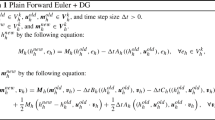Abstract
A new characteristic approach that guarantees the conservative property is proposed and is applied to the shallow water equations. CIP-CSL (Constrained Interpolation Profile/Conservative Semi-Lagrangian) interpolation is applied to the CIP method of characteristics in order to enhance the mass conservation of the numerical result. Although the characteristic formulation is originally derived from non-conservative form, present scheme achieves complete mass conservation by solving mass conservation simultaneously and reflecting conserving mass in interpolation profile. Present method has less height error compared to the CIP method of characteristics by several orders of magnitude. By the enhanced conservation property, present scheme is applicable to nonlinear problems, such as a shock problem. Furthermore, application to two dimensions including the Coriolis term is straightforward with directional splitting technique.
Similar content being viewed by others
References
Arakawa A, Lamb VR (1981) A potential enstrophy and energy conserving scheme for the shallow water equations. Mon Weather Rev 109: 18–36
Kashiyama K, Ito H, Behr M, Tezduyar TE (1995) Three-step explicit finite element computation of shallow water flows on a massively parallel computer. Int J Numer Meth Fluids 21: 885–900
Kashiyama K, Saitoh K, Behr M, Tezduyar TE (1997) Parallel finite element methods for large-scale computation of storm surges and tidal flows. Int J Numer Meth Fluids 24: 1371–1389
Kashiyama K, Ohba Y, Takagi T, Behr M, Tezduyar TE (1999) Parallel finite element method utilizing the mode splitting and sigma coordinate for shallow water flows. Comput Mech 23: 144–150
Tezduyar TE (2001) Finite element methods for flow problems with moving boundaries and interfaces. Arc Comput Methods Eng 8: 83–130
Lauritzen PH, Kaas E, Machenhauer B (2006) A mass-conservative semi-implicit semi-Lagrangian limited-area shallow-water model on the sphere. Mon Weather Rev 134: 1205–1221
Staniforth A, Côté J (1991) Semi-Lagrangian integration schemes for atmospheric models—a review. Mon Weather Rev 119: 2206–2223
Erbes G (1993) A semi-Lagrangian method of characteristics for the shallow-water equations. Mon Weather Rev 121: 3443–3452
Yabe T, Aoki T (1991) A universal solver for hyperbolic equations by cubic-polynomial interpolation. I. One-dimensional solver. Comput Phys Commun 66: 219–232
Yabe T, Ishikawa T, Wang PY (1991) A universal solver for hyperbolic equations by cubic-polynomial interpolation. II. Two- and three-dimensional solver. Comput Phys Commun 66: 233–242
Ogata Y, Yabe T (2004) Multi-dimensional semi-Lagarangian characteristic approach to the shallow water equations by the CIP method. Int J Comput Eng Sci 5(3): 699–730
Leonard BP, Lock AP, Macvean MK (1996) Conservative explicit unstricted-time-step multidimensional constancy-preserving advection schemes. Mon Weather Rev 124: 2588–2606
Yabe T, Xiao F, Utsumi T (2001) Constrained interpolation profile method for multiphase analysis. J Comput Phys 169: 556–593
Yabe T, Tanaka R, Nakamura T, Xiao F (2001) An exactly conservative semi-Lagrangian scheme (CIP-CSL) in one dimension. Mon Weather Rev 129: 332–344
Tanaka R, Nakamura T, Yabe T (2000) Constructing exactly conservative scheme in non-conservative form. Comput Phys Commun 126: 232–243
Nakamura T, Tanaka R, Yabe T (2001) Multi-dimensional conservative scheme in non-conservative form. CFD J 9: 437–453
Nakamura T, Tanaka R, Yabe T, Takizawa K (2001) Exactly conservative semi-Lagrangian scheme for multi-dimensional hyperbolic equations with directional splitting technique. J Comput Phys 174: 171–207
Toda K, Ogata Y, Yabe T (2009) Multi-dimensional conservative semi-Lagrangian method of characteristics CIP for the shallow water equations. J Comput Phys 228: 4917–4944
Stoker J (1957) Water waves: the mathematical theory with applications. Interscience, New York
Utsumi T, Kunugi T, Aoki T (1997) Stability and accuracy of the cubic interpolated propagation scheme. Comput Phys Commun 101: 9–20
Takewaki H, Yabe T (1987) Cubic-interpolated pseudo particle (CIP) method : application to nonlinear or multi-dimensional problems. J Comput Phys 70: 355–372
Toro EF (1997) Riemann solvers and numerical methods for fluid dynamics. Springer, Berlin
Dritschel DG, Polvani LM, Mohebalhojeh AR (1999) The contour-advective semi-Lagrangian algorithm for the shallow water equations. Mon Weather Rev 127: 1551–1565
Sadourny R (1972) Conservative finite-difference approximations of the primitive equations on quasi-uniform spherical grids. Mon Weather Rev 100: 136–144
Chen C, Xiao F (2008) Shallow water model on cubed-sphere by multi-moment finite volume method. J Comput Phys 227: 5019–5044
Yabe T, Mizoe H, Takizawa K, Moriki H, Im H-N, Ogata Y (2004) Higher-order schemes with CIP method and adaptive Soroban grid towards mesh-free scheme. J Comput Phys 194: 57–77
Takizawa K, Yabe T, Tsugawa Y, Tezduyar TE, Mizoe H (2007) Computation of free-surface flows and fluid-object interactions with the CIP method based on adaptive meshless soroban grids. Comput Mech 40: 167–183
Yabe T, Takizawa K, Tezduyar TE, Im H-N (2007) Computation of fluid-solid and fluid-fluid interfaces with the CIP method based on adaptive soroban grids—an overview. Int J Numer Meth Fluids 54: 841–853
Takizawa K, Tanizawa K, Yabe T, Tezduyar TE (2007) Ship hydrodynamics computations with the CIP method based on adaptive soroban grids. Int J Numer Meth Fluids 54: 1011–1019
Author information
Authors and Affiliations
Corresponding author
Rights and permissions
About this article
Cite this article
Yabe, T., Ogata, Y. Conservative semi-Lagrangian CIP technique for the shallow water equations. Comput Mech 46, 125–134 (2010). https://doi.org/10.1007/s00466-009-0438-8
Received:
Accepted:
Published:
Issue Date:
DOI: https://doi.org/10.1007/s00466-009-0438-8




